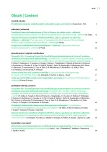The importance of evaluating the effectiveness of the ventilation VE/VCO2 slope in patients with heart failure
Authors:
Filip Dosbaba 1,2,4; Petra Žurková 3; Ladislav Baťalík 1,2; Hana Dosbaba 1; Marián Felšőci 2; Robert Vysoký 1,5; Jindřich Špinar 2,4; Ondřej Ludka 2,4
Authors‘ workplace:
Rehabilitační oddělení FN Brno, pracoviště Bohunice
1; Interní kardiologická klinika LF MU a FN Brno, pracoviště Bohunice
2; Plicní rehabilitace, Mepha Centrum, Ostrava
3; Mezinárodní centrum klinického výzkumu FN u sv. Anny v Brně
4; Ústav ochrany a podpory zdraví LF MU Brno
5
Published in:
Vnitř Lék 2017; 63(1): 56-59
Category:
Reviews
Overview
Chronic Heart Failure (CHF) is accompanied by a whole range of symptoms, which significantly decrease the quality of life; these typically concern dyspnoea, fatigue and exercise intolerance. The objectification of the patient’s condition but must have an effective means of evaluation. One such resource is cardiopolmonary exercise (CPX) testing with it is functional parameters. CPX test with its functional parameters is one of such means. VO2peak is undoubtebly the parameter, which was used the most often in the past 25 years, however, it has many limitations. It is reason, why the evaluation of ventilation effectiveness using the VE/VCO2 slope is becoming more and more the centre of Czech and foreign interest of cardiologists abroad. Foreign studies have unambiguously proven that because of the absence of the fundamental limitations, such as in case of VO2peak, the VE/VCO2 slope is a stronger predictor of the amount of hospitalizations and of mortality in the population of patients suffering from CHF. This short overview intends to inform of the significant merit of this parameter. That is the reason why the VE/VCO2 should be classified as a standard criterion in indication of heart transplantations, but also in evaluation of seriousness and prognosis in population of patient suffering from HF.
Key words:
heart failure – mortality – prognosis – ventilation efficiency – VE/VCO2 slope
Sources
1. Špinar J, Vítovec J, Hradec J et al. Doporučený postup České kardiologické společnosti pro diagnostiku a léčbu chronického srdečního selhání. Cor et Vasa 2012; 54(3–4): 161–182 (e e113-e134). Dostupné z DOI: <http://dx.doi.org/10.1016/j.crvasa.2012.03.002>..
2. Arena R, Myers J, Guazzi M. The clinical and research applications of aerobic capacity and ventilatory efficiency in heart failure: an evidence-based review. Heart Fail Rev 2008; 13(2): 245–269.
3. Myers J, Arena J, Oliveira RB et al. The Lowest VE/VCO2 Ratio during Exercise as a Predictor of Outcomes in Patinets with Heart Failure. J Card Fail 2009; 15(9): 756–762. Dostupné z DOI: <http://dx.doi.org/10.1016/j.cardfail.2009.05.012>.
4. Jaussaud J, Aimable L, Douard H. The time for a new strong functional parameter in heart failure: VE/VCO2 slope. Int J Cardiol 2011; 147(2): 189–190. Dostupné z DOI: <http://dx.doi.org/10.1016/j.ijcard.2010.10.110>.
5. Mancini D, Eisen H, Kussmaul W et al. Value of peak exercise oxygen consumption for optimal timing of cardiac transplantation in ambulatory patients. Circulation 1991; 83(3): 778–786.
6. Arena R, Myers J, Aslam SS et al. Peak VO2 and VE/VCO2 slope in patinets with heart failure: A prognostic comparison. Am Heart J 2004; 147(2): 354–360. Dostupné z DOI: <http://dx.doi.org/10.1016/j.ahj.2003.07.014>.
7. Balady JG, Arena R, Sietsema K et al. Clinician’s Guide to Cardiopulmonary Exercise Testing in Adults. Circulation 2010; 122(2): 191–225. Dostupné z DOI: <http://dx.doi.org/10.1161/CIR.0b013e3181e52e69>.
8. Arena R, Myers J, Aslam SS et al. Technical considerations related to the minute ventilation carbon dioxide output slope in patients with heart failure. Chest 2003; 124(2): 720–727.
9. Belli JF, Bacal F, Bocchi EA et al. Ergoreflex Activity in Heart Failure. Arq Bras Cardiol 2011; 97(2): 171–178.
10. Piepoli MF, Coats AJ. The “skeletal muscle hypothesis in heart failure” revised. Eur Heart J 2013; 34(7): 486–488. Dostupné z DOI: <http://dx.doi.org/10.1093/eurheartj/ehs463>.
11. Ukkonen H, Burwash IG, Dafoe W et al. Is ventilatory efficiency (VE/VCO2 slope) associated with right ventricular oxidative metabolism in patients with congestive heart failure? Eur J Heart Fail 2008; 10(11): 1117–1122. Dostupné z DOI: <http://dx.doi.org/10.1016/j.ejheart.2008.08.010>.
12. Gibelin P, Aldossari H, Bertora D et al. New Parameters of Cardiopulmonary Exercise Testing in Patients with Chronic Heart Failure: Practical Applications. IJCM 2012; 3: 532–537. Dostupné z DOI: <http://dx.doi.org/10.4236/ijcm.2012.36096>.
13. Arena R, Myers J, Abella J et al. Development of a Ventilatory Classification System in patients with heart failure. Circulation 2007; 115(18): 2410–2417.
14. Jankowska EA, Witkowsky T, Ponikowska B, et al. Excessive ventilation during early phase of exercise: a new predictor of poor long-term outcome in patients with chronic heart failure. Eur J Heart Fail 2007; 9(10): 1024–1031.
15. Chaloupka V, Elbl L et al. Zátěžové metody v kardiologii. Grada: Praha 2003. ISBN 80–247–0327–0.
16. Ludka O, Trna J, Galková L et al. Use fullness of exercise tissue doppler echocardiography for prognostic stratification of congestive heart failure patients with left ventricular systolic dysfunction. Biomed Pap Med Fac Univ Palacky Olomouc Czech Repub 2012; 157(1): 27–34. Dostupné z DOI: <http://dx.doi.org/10.5507/bp.2012.014>.
17. Corra U, Giordano A, Bosimini E et al. Oscillatory Ventilation During Exercise in Patients With Chronic Heart Failure: Clinical Correlates and Prognostic Implications. Chest 2002; 121(5): 1572–1580.
Labels
Diabetology Endocrinology Internal medicineArticle was published in
Internal Medicine

2017 Issue 1
Most read in this issue
- Closure of the left atrial appendage by means of the AtriClip System
- The importance of evaluating the effectiveness of the ventilation VE/VCO2 slope in patients with heart failure
- Rituximab-associated progressive multifocal leukoencephalopathy
- A contribution to the differential diagnostics of sclerosing cholangitides
